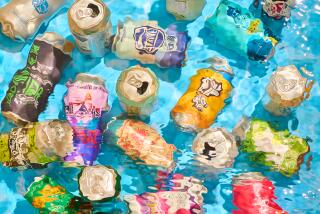Using Substitute for Double Whipping Cream
- Share via
Question: A recipe from a book published in the 1800s, given to me by my grandmother, calls for double cream. What is this and can it be made today?
Answer: Dr. John Bruhn, Extension food technologist (dairy processing specialist) at UC Davis tells us that double cream has a butterfat content of 42% and is not sold at the consumer level in the United States. Heavy whipping cream, which must be at least 36% butterfat, may be a satisfactory substitution in some recipes.
According to Bruhn, some companies exceed the minimum, producing a 38% butterfat product. Check with local dairies, then purchase the product with the highest level. Also be aware of the distinction between heavy whipping cream with 36% butterfat and cream for whipping, which has only 30% butterfat.
Q: Is it possible to make popcorn in the microwave (perhaps in a paper bag) instead of buying the packets of microwave popcorn at the supermarket?
A: Popcorn may be prepared using any of the plastic popcorn poppers designed specially for microwave ovens. Ordinary paper bags should not be used, however, because the bag can ignite from the intense heat buildup during popping.
Thelma Pressman, author of “The Art of Microwave Cooking” (Contemporary Books: 1983) suggests using half a cup unpopped corn per batch and HIGH power. She warns that you will not get the same yield from corn popped in the microwave as on a stove top and cautions not to attempt to continue popping the corn for more than about 4 1/2 minutes or it will burn.
Q: I have some questions about jicama. Where is it grown? Does it have any nutritional value? Are there any ways to serve it other than raw in salads or with dips? Is it ever cooked?
A: According to “Vegetables” by Delphine Hirasuna, Kit Hinrichs, Tom Tracy and Diane J. Hirasuna (Chronicle: $14.95), jicama is called sa gord in China and has been part of the Asian diet since the 17th Century. The Chinese use it like water chestnuts in stir-fry dishes. Since it is also grown and eaten in Mexico, California’s large Mexican population probably introduced jicama to the United States.
Peak season is August through October. In addition to being eaten raw, jicama may be baked, boiled, braised or added to stews like turnips, the authors say. Unpeeled jicama can be stored in the refrigerator for at least two weeks.
“Nutritive Value of American Foods,” USDA Handbook 456, states that one pound of jicama contains 225 calories, 5.7 grams of protein, 0.8 grams fat, 52.2 grams carbohydrate, 61 milligrams calcium, 73 milligrams phosphorus, 2.4 milligrams iron, a trace of Vitamin A, 0.16 milligrams thiamine, 0.12 milligrams riboflavin, 1.2 milligrams niacin and 82 milligrams ascorbic acid.
Q: Can prepared mustard be made at home?
A: In their book “Better Than Store Bought” (Harper & Row: 1979), Helen Witty and Elizabeth Schneider Colchie claim some mustards, such as Dijon and mild brown, are “cheaper and better when store-bought.” They feel the coarse-grained varieties, such as their Coarse-Ground Mustard With Red Wine and Garlic, are the most satisfying to make at home.
This is a robust, assertive mustard with deep color from the red wine. The texture is similar to that of the French country mustards, but it does not have as thick a consistency.
COARSE-GROUND MUSTARD WITH RED WINE AND GARLIC
1/4 cup mustard seeds
1/4 cup red wine
1/3 cup red wine vinegar
1/4 cup water
1/4 teaspoon ground allspice
1/2 teaspoon honey
1/4 teaspoon black pepper
1/2 teaspoon pureed garlic
1 1/2 teaspoons coarse ground salt
1 bay leaf, finely crumbled
Combine mustard seeds, red wine and red wine vinegar in bowl and let stand 3 hours or more. Place mixture in food processer or blender and add water, allspice, honey, pepper, garlic, salt and bay leaf. Process to fairly coarse texture.
Transfer mixture to top of double boiler. Stir over simmering water 5 to 10 minutes or until mustard has slightly thickened. Place in jar, cool, then cap and refrigerate. Makes 3/4 to 1 cup.
Address questions on food preparation to You Asked About . . . , Food Section, The Times, Times Mirror Square, Los Angeles 90053. Personal replies cannot be given.
More to Read
Eat your way across L.A.
Get our weekly Tasting Notes newsletter for reviews, news and more.
You may occasionally receive promotional content from the Los Angeles Times.










